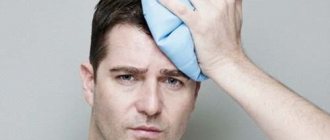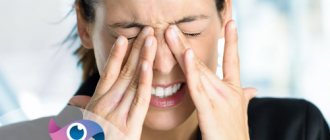A headache is, according to neurologists, any feeling of discomfort that is localized in the head area. Headache and nausea are two symptoms that often occur in patients who have suffered a traumatic brain injury, acute cerebrovascular accident, or those suffering from various diseases of the central nervous system.
Neurologists, oncologists, hematologists, and doctors of other specialties at the Yusupov Hospital make a collegial decision regarding patient management tactics. Complex cases of headache and nausea are discussed at an expert council meeting. Professors and associate professors, candidates and doctors of medical sciences take part in its work. Patients of the neurology clinic have the opportunity to undergo complex diagnostic procedures and neurosurgical interventions in partner clinics of the Yusupov Hospital located in Moscow.
Causes and characteristics of different types of headaches
Headache, nausea, weakness can occur under the influence of stress.
Headache, which is a consequence of anxiety, depression of various types, developing under the influence of everyday and work troubles, is quite common among patients at the Yusupov Hospital. It develops due to excessive tension in the muscles attached to the skull. This disease affects people of all ages, but especially from 25 to 60 years old. Typically, the intensity of the disease remains at the same level and does not increase with physical activity. Pain sensations are concentrated in the temporal, occipital or frontal areas. The pain is either compressive in nature; patients report that their head feels like they are being pulled in by a helmet.
Often headaches and nausea in both men and women occur in the presence of pathology of the central nervous system. This condition can occur due to traumatic brain injury when patients experience increased intracranial pressure. As a result of liquor hypertension, headache, nausea, and vomiting occur, which does not bring relief.
Headache and nausea may be a sign of meningitis. This is an infectious disease in which inflammation of the membranes of the spinal cord develops. In patients with meningitis, body temperature rises to high levels. They experience severe pain when trying to bring their head to their chest or straighten their knees. Infectious disease specialists and neurologists at the Yusupov Hospital carry out a comprehensive examination and adequate treatment of meningitis with the latest antibacterial drugs.
During a hypertensive crisis, women and men complain of headache, mainly in the occipital region, nausea, and dizziness. They vomit, which does not bring relief. During a hypertensive crisis, cardiologists at the Yusupov Hospital prescribe antihypertensive drugs to patients, drugs that improve brain nutrition and heart function. Stabilizing blood pressure helps prevent acute cerebrovascular accident - stroke.
Regardless of the patient's gender, nausea, vomiting and headache can be signs of food poisoning, a side effect of certain medications, anorexia and diabetes.
One of the most common causes of headaches and nausea is cerebrovascular disease. Headache associated with increased intracranial pressure may be an early sign of a brain tumor. It intensifies with sneezing, coughing, tilting the head, and is often accompanied by vomiting without previous nausea and transient visual impairment.
Headache, nausea, and dizziness often bother patients with cervical osteochondrosis, protrusion of intervertebral discs, and spinal hernias. The pain is usually localized in the cervical-occipital region. It often spreads to the temporal and frontal areas of the head, shoulder and upper limb. The headache intensity is moderate. The pain intensifies with prolonged stay in an uncomfortable position, sudden movement of the head, or pressure on the cervical-occipital muscles. Mobility of the cervical spine is limited.
After a traumatic brain injury, headaches may persist for several months. It is diffuse, dull, intensifies with physical activity and is accompanied by the following symptoms:
- Memory impairment;
- Decreased attention;
- Impaired sleep quality;
- Emotional disorders (low mood, tearfulness);
- Increased fatigue;
- Dizziness.
Doctors at the Yusupov Hospital identify the cause of headaches and dizziness using modern laboratory and instrumental research methods.
After analyzing the research results, complex therapy is carried out with the latest drugs, which are effective and have a minimal range of side effects. Make an appointment
Reasons why headaches occur in the temples and forehead
There are many reasons why a headache occurs in the forehead and temples. These symptoms often indicate a temporary or chronic disruption of the blood supply to brain cells. It is important to find out the exact cause of the deterioration in health in order to select an effective treatment regimen. The development mechanism for various pathologies is different, so treating a single symptom is ineffective - it is necessary to eliminate the main factor that provokes oxygen starvation of brain cells.
Physiological reasons
There are physiological reasons for headaches in the temples and forehead in a healthy person. This means that a medical examination will not show any abnormalities. In most cases, the patient needs proper rest, and in case of acute pain, take painkillers. Deterioration in health may be caused by the following factors:
- intense physical activity without sufficient rest is one of the causes of vascular disorders and pressing pain in the temples;
- mental stress, prolonged work at a monitor or with small parts are one of the causes of pain;
- heat stroke - prolonged exposure to open sunlight or high temperatures provokes acute headaches, dizziness and weakness;
- disruption of sleep, work and physical activity - lack of rest is especially dangerous;
- a sharp change in weather conditions, including atmospheric pressure, causes disturbances in vascular tone and painful sensations in the temples.
Stress and chronic fatigue are a common cause of headaches and pressure on the temples and forehead. These symptoms disappear after proper rest and return when the regime is violated again. Doctors recommend avoiding overwork, as it causes increased stress on the heart and blood vessels, disorders of the nervous and other systems.
Migraine
Migraine is an acute headache that occurs without a specific cause. The examination does not reveal any organic disorders, damage to blood vessels or the brain. It is often one-sided, affecting the left or right side of the head, the temple area. Migraines manifest themselves in attacks that last up to several hours, and moderate pain can persist for up to several days.
A characteristic feature of migraine is its aura. It includes symptoms that begin to appear some time before the main headache attack. It can be determined by the following characteristics:
- weakness, drowsiness, decreased concentration;
- increased sensitivity to bright light, loud sounds;
- nausea;
- auditory and visual hallucinations (appearance of dark circles in the field of vision) are possible.
Migraine is a chronic disease that can first appear in both childhood and adults. If attacks occur frequently, you may notice a certain relationship with the factors that cause them. Thus, in some patients, migraine worsens at certain times of the year and is associated with moving or other reasons. To treat this disease, special medications are prescribed, since conventional painkillers available for use at home do not have the necessary effect.
Vascular diseases
Severe headaches in the forehead and temples are often caused by insufficient blood supply to certain areas of the brain. The main reason for this is the weakness of the blood vessels and insufficient elasticity of their walls. Vascular pathologies can be congenital or acquired, and often appear in old age. They lead to ischemia of cells and tissues, as a result of which they cannot perform their functions. There are several diseases that can cause oxygen starvation of brain cells, headaches in the temples and frontal part.
- Hypertension is a persistent increase in blood pressure. This condition leads to a decrease in vascular tone and provokes a greater load on the heart. Blood pressure readings must be stabilized by taking medications and a special regimen of physical activity. Attacks of hypertension are dangerous because there is a risk of rupture of important vessels and the development of hemorrhagic stroke.
- Hypotension – decreased blood pressure. This is an equally dangerous condition in which ischemia of brain tissue occurs. Blood and nutrients are supplied to the cells in insufficient quantities. Chronic low blood pressure can cause ischemic stroke, as well as pressing pain in the temples and frontal part of the head.
- Atherosclerosis is a chronic metabolic disorder in which the level of cholesterol and lipoproteins in the blood increases. This leads to the formation of plaques on the inner wall of the arteries. The main danger of the disease is the narrowing of the lumen of blood vessels, which entails insufficient blood flow to certain areas and at the same time an increase in blood pressure.
The elasticity of veins and arteries decreases in old age. However, vascular disorders can also occur in young people and children. Among the main causes of headaches in the frontal region and temples caused by vascular diseases are poor diet, excess consumption of fatty foods, excess weight, excessive physical activity or a sedentary lifestyle. Doctors recommend periodically undergoing examinations and measuring blood pressure, since chronic diseases in the early stages can be asymptomatic.
Diseases of the cervical spine
If a patient often has headaches, forehead and temples, this may indicate diseases of the cervical spine. This area contains important arteries that carry blood to the brain. Their compression leads to ischemia of cells and tissues, deterioration in the functioning of individual areas. For pain in the head, forehead and temples, a comprehensive diagnosis is required to determine the most common neck diseases.
- Cervical osteochondrosis is one of the most common disorders. The disease is manifested by dystrophic changes in the bone and cartilage tissues of the vertebrae, deterioration of their nutrition and blood supply. This leads to overgrowth of the bone surfaces of the joints, the formation of uneven edges, osteophytes and growths. These formations compress the vessels and block blood access to important areas of the brain, causing ischemia.
- Vertebral subluxations are a displacement of the articular surfaces of bones, as a result of which the segments do not lose their integrity, but change their location relative to each other. They arise as a result of injuries, degenerative processes, weakness of muscles and ligaments. Subluxation causes acute pain in a certain area of the neck and decreased motor activity. In addition, it may be the reason why the frontal part of the head and temples hurt.
- Deformation of the spine is a deviation of its axis in the anterior, posterior or lateral directions. The process can develop both in childhood and in adults. It is accompanied by headaches in the frontal and temporal parts, dizziness, and painful sensations during movement. It is important to undergo periodic examinations and follow recommendations for the treatment of scoliosis, lordosis or kyphosis, since the disease can progress.
For pain in the frontotemporal part of the head associated with diseases of the cervical spine, complex treatment is recommended. The doctor prescribes exercises to strengthen muscles and stretch ligaments that will support the spine and prevent its further curvature. In some cases, surgery may be required. It is necessary if the vertebrae are severely deformed, block movements in the neck and cause acute pain.
Eye diseases
Diseases of the visual system can also cause pain in the frontotemporal part of the head. The cause is constant eye strain, inflammatory processes, and blurred vision. These diseases require regular examination by an ophthalmologist, wearing glasses or contact lenses, and drug treatment. In some pathologies (cataracts), surgical intervention is possible, which will restore vision and stop the further development of the disease.
- Cataract is clouding of the lens. This organ acts as a lens and is involved in the refraction of light. If it becomes opaque, vision gradually deteriorates until it is completely lost. Most cases of cataracts are associated with age-related changes. The disease can also be caused by injuries, diabetes, certain eye diseases, or be congenital.
- Conjunctivitis is an inflammation of the conjunctiva, the mucous membrane of the eye. The disease is most often caused by a viral infection, less often by a bacterial infection. It is manifested by redness of the eyes, lacrimation, exacerbation of the reaction to bright light, headaches in the temples and frontal part. All cases of conjunctivitis require timely treatment, since they can be complicated by the addition of a bacterial infection and the development of purulent inflammation.
- Astigmatism is a disease caused by an irregular shape of the cornea, or less commonly, the lens of the eye. In this case, the ability to focus on near or distant objects is impaired, and the image looks blurry. For astigmatism, glasses or contact lenses are prescribed, and some patients require surgery.
If the patient has a severe headache, forehead and temples after changing glasses or contact lenses, it is worth contacting an ophthalmologist. Their incorrect selection causes tension in the muscles of the eyeball due to difficulties focusing on near or distant objects. In this case, you should contact your ophthalmologist to change lenses. However, a short period of adaptation to new glasses is considered normal, and during the first few days a person may experience headaches, temples and forehead pain.
Infectious diseases
Flu, sore throat, ARVI are common consequences of decreased immunity during the cold season. These diseases are manifested by soreness and sore throat, fever, cough, headache in the frontal and temporal parts. They are caused by a viral infection that spreads quickly through airborne droplets and is therefore highly contagious (infectious). Treatment involves bed rest, drinking plenty of fluids, and, if necessary, taking antipyretics, vitamins and antibiotics.
Meningitis is one of the most dangerous reasons why the frontal part of the head and temples hurt. It is manifested by inflammation of the soft, arachnoid or hard membranes of the brain. The main symptom is acute pain that does not stop even with bed rest. Meningitis can be caused by a viral or bacterial infection; the most dangerous form is meningococcal inflammation. The treatment regimen is based on antibiotics, which must be selected separately according to the type of pathogen.
Pathologies of the central nervous system
If you often have a headache in your temples and frontal area, this may indicate various pathologies of the central nervous system. Inflammatory or degenerative changes in nerve fibers provoke acute headaches. They must be distinguished from brain tumors and infectious diseases. Traumatic brain injuries can also cause long-term effects such as headaches.
Disorders of the central nervous system can be diagnosed at any age. However, older people are more susceptible to developing dystrophic changes in cells and tissues. It is important to monitor your well-being and if you experience frequent headaches, absent-mindedness, or memory loss, consult a doctor for a comprehensive examination.
Other reasons
There are a huge number of reasons why the head hurts in the frontal part and temples. Some of them do not require emergency treatment and occur periodically in most people. However, a number of disorders can progress and lead to dangerous complications, so it is important to seek medical help in a timely manner. Painful sensations may be a symptom of the following disorders:
- inflammatory diseases of the maxillary sinuses;
- inner ear diseases;
- increased intracranial pressure;
- benign and malignant neoplasms in the brain;
- pathologies of the endocrine system, which leads to hormonal imbalance and chronic metabolic diseases;
- Stroke is an acute disorder of blood circulation in the brain.
A large part of the population suffers from dependence on weather conditions. The most difficult period is a sharp change in atmospheric pressure. When the weather changes, as well as when moving to another climate zone, acute headache, nausea and weakness, and decreased performance are observed.
Headache in women
Migraines are often the cause of severe headaches and nausea.
Patients experience periodically recurring attacks of intense, pulsating headaches that last up to three days. Usually, unpleasant sensations appear in one half of the head, mainly in the forehead, eyes or one of the temples. Migraine headaches are aggravated by physical activity. It may be accompanied by nausea, vomiting, drowsiness and lethargy. Patients cannot tolerate bright lights and loud sounds. Young women are most often affected by migraines. This is facilitated by the rich hormonal background of the body, characteristic of the age of 25-30 years. An attack is the result of an increase in functional activity in specific centers of the brain.
In women, headaches and nausea occur more often for the following reasons:
- Severe fatigue or stress;
- Anemia (anemia);
- Hormonal changes;
- Brain tumors;
- Meningitis;
- Encephalitis.
Headache in men
Short-term pain that occurs during physical effort in men is not a sign of disease.
This category also includes headaches that occur in men during sexual intercourse and last for several minutes. If an intense headache occurs during orgasm and persists for several hours, you should consult a doctor. If headaches and nausea are regular, neurologists at the Yusupov Hospital conduct an examination using modern neuroimaging methods. They make it possible to detect a brain tumor at the initial stage of development. For timely treatment of a dangerous disease, doctors recommend that patients who are worried about nausea, dizziness, or headache in the morning immediately contact a neurology clinic.
Diagnostics
Neurologists at the Yusupov Hospital determine the cause of headaches and nausea using the following modern research methods:
- Electroencephalography;
- Echoencephalography;
- Rheoencephalography;
- Doppler ultrasound of head and neck vessels;
- Magnetic resonance and computed tomography of the brain;
- X-rays of the skull;
- Fundus examinations.
Patients receive consultation from related specialists (vertebrologist, otolaryngologist, oncologist, cardiologist, ophthalmologist).
What Can Cause Frontal Headaches?
Causes of pain can be diseases (hypertension, infectious viral pathology, neurological, mental, eye and other diseases), injuries, congenital pathology of the skull, and the effects of external harmful factors - temperature, changes in atmospheric pressure, strong wind, toxic substances , airborne, industrial, household and food poisons. In some cases, a headache in the frontal region requires urgent treatment and is a specific sign of a certain pathology. Among the causes of headaches in the frontal region that need to be treated, special mention should be made of sinusitis - inflammation of the paranasal sinuses. Severe frontal pain is caused by frontal sinusitis, an inflammatory process of the frontal sinus. The nature of the pain is quite strong and constant. During the purulent process, a feeling of pulsation, distension appears, and the temperature rises sharply. Frontal pain can be provoked by diseases of the eyes and fundus, as well as pathological processes in the upper jaw and teeth.
Pharmacological therapy
Doctors at the Yusupov Hospital take an individual approach to relieving headache attacks with nausea in each patient. For migraines, the following medications are prescribed:
- Antidepressants (lerivone, amitriptyline);
- Beta-blockers (anaprilin, propranolol, obzidan);
- Calcium channel blockers (nimodipine);
- Non-steroidal anti-inflammatory drugs (indomethacin, piroxicam, naprosyn);
- Serotonin antagonists (pizotifen, cyproheptadine);
- Anticonvulsants (apilepsin, carbamazepine);
- Muscle relaxants (mydocalm, sirdalud).
Complex medications taken during an aura help prevent a migraine attack. If the cause of headaches and dizziness in women is menstruation, doctors prescribe non-steroidal anti-inflammatory drugs. You can prevent a migraine attack by following the following recommendations from doctors:
- Limit the consumption of foods that contain tyramine (red wine, dark chocolate, nuts, cheese, citrus fruits);
- Perform therapeutic exercises with an emphasis on the cervical spine;
- Massage the collar area;
- Take a course of acupuncture.
Professors, doctors of medical sciences, who work at the neurology clinic of the Yusupov Hospital, use their own methods of psychotherapy and biofeedback to treat headaches and nausea. Neurologists prescribe the following medications to patients:
- Non-narcotic and narcotic analgesics;
- Ergot alkaloid derivatives;
- Triptans;
- Antiepileptic drugs;
- Antihypertensive drugs;
- Botulinum toxin preparations.
All medications that neurologists use for headaches and nausea are divided into two groups: drugs for relieving headache attacks and prophylactic agents.
The first group of pharmacological drugs includes non-narcotic analgesics and non-steroidal anti-inflammatory drugs (ketonal, naproxen, paracetamol, ibuprofen). Patients suffering from diseases of the gastrointestinal tract are advised by a gastroenterologist before starting therapy with these drugs. To prevent complications, doctors prescribe proton pump inhibitors. Preventive therapy is carried out for those patients who often experience severe attacks of headaches. In most cases, medications are prescribed in courses lasting from several months to several years. To prevent headaches and nausea, neurologists prescribe beta blockers, antiepileptic drugs, calcium channel blockers, and antidepressants to patients.
Some patients are given monotherapy (treatment with one drug), while in other cases combination therapy is preferred. Each drug is initially prescribed at the minimum effective dose, and then, if indicated, the dose is increased. This allows you to reduce the severity of side effects of the therapy.
Make an appointment
Content:
- What pathologies accompanied by intoxication provoke headaches?
- Features of intoxication pain
- Treatment of pain associated with intoxication
Often, poisoning of the body (intoxication) of various etiologies occurs with the appearance of pain in the head area. Moreover, conventional painkillers may not have the expected effect. Elimination of headaches in these cases is only possible with the use of comprehensive detoxification.
Prevention
What to do if you have a severe headache and nausea? A few tips can help reduce the frequency of migraine attacks:
- you should reduce the consumption of foods and drinks that provoke attacks;
- avoid long breaks in meals;
- sleep at least 8 hours a day;
- avoid stressful loads;
- quit smoking;
- increase physical activity, especially swimming;
- spend more time in the fresh air;
- avoid long trips by car, bus, boat;
- Do not stay in a room with strong unpleasant odors.
Non-drug therapy
Frequent headaches occur when the neck muscles are tense.
The initiator of the cascade of events that ultimately lead to physical or biochemical changes that provoke headaches is the “sticking together” of soft tissues (muscle, connective tissue, tendons and ligaments) and pinching of peripheral nerves. In this case, rehabilitation specialists at the Yusupov Hospital carry out therapy aimed at removing mechanical restrictions in the entire kinetic chain of the body: in the jaw, neck, and shoulder girdle. When a nerve is pinched, in addition to the tension headache itself, the following symptoms occur:
- Nausea,
- Numbness;
- Tingling;
- Burning;
- Increased sensitivity.
Doctors at the Yusupov Hospital Neurology Clinic have extensive clinical experience in treating headaches and nausea.
They reduce the severity of these symptoms or neutralize them through a combination of drug treatment methods with a properly selected set of gymnastic exercises. Specialists at the rehabilitation clinic perform acupuncture, various types of massage, and physiotherapeutic procedures for headaches and nausea. Rehabilitators are fluent in various types of massage, osteopathic and soft manual techniques, and kinesiotaping. They use innovative methods of non-drug therapy for headaches and nausea:
- Biofeedback;
- Kinesiotherapy;
- Laser therapy.
In order to undergo an effective course of treatment for headaches and nausea, make an appointment with a neurologist at the Yusupov Hospital online or by calling the call center at any time of the day.
Make an appointment
Literature:
- Emergency syndromology. Emergency medical care [Electronic resource]: prehospital diagnosis of emergency pathological conditions and justification of emergency treatment and tactical decisions: practical guidance / A. N. Nagnibeda. - St. Petersburg: SpetsLit, 2010. - 351 p.
- Endogenous intoxication syndrome (manual) [Text] / S. G. Musselius. — Ed. 2nd, revised and additional - Moscow: Author's book, 2019. - 356 p.
- General medical practice: manual / [Abdullahodzhaeva M.S. et al.]; Ch. ed.: F.G. Nazyrov, A.G. Gadaev. - M.: GEOTAR-Media, 2005 (JSC Tip. News). — 99
The text was checked by expert doctors: Head of the socio-psychological service of the Alkoklinik MC, psychologist Yu.P. Baranova, L.A. Serova, a psychiatrist-narcologist.
CAN'T FIND THE ANSWER?
Consult a specialist
Or call: +7 (495) 798-30-80
Call! We work around the clock!









